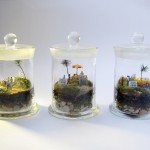If you’re a musician yearning to record that ground-breaking album that you know will change the world (or at least propel your name into musical conversation) the good news is that you really don’t need the keys to Abbey Road in order to make it a reality. The equipment available to the modern home recording studio is many times more powerful than the old four-track that The Beatles recorded Sgt Pepper’s Lonely Hearts Club Band on.
See also…
- Cooking without a kitchen
- On the record: how to store your vinyl well
- From bedroom to brewery: how home-brewing has become London’s newest hobby
Of course, the idea of home recording is hardly anything new: everyone from Les Paul to Led Zeppelin, Radiohead to the Rolling Stones have experimented with mobile studios and lo-fi equipment at some point in their careers, but while it’s true that the likes of Exile on Main Street weren’t recorded in a studio, per se, it hardly seems in the spirit of ‘home recording’ when the home in question is some palatial pad on the French Riviera, borrowed off a friend for the weekend.
Nope, with the idea of ‘better living in small spaces’ ever close to our hearts here at Boxman, we’re interested in the art of recording in small spaces not obviously suited to the acoustic quirks of a major studio. And it turns out the idea appeals to a whole host of musicians, some predictably lo-fi, and others less obviously so. Take The Prodigy’s Liam Howlett, for instance, who said recently, “My studio is crammed with equipment, but I ended up feeling I was being overcome by it all – it was just too much”.
Take it from Liam: sometimes it’s the familiar surroundings of your home that get the creative juices flowing.
The Prodigy
“People always go on about bedroom studios, and when I first had a studio, it was in my bedroom” says Liam Howlett of The Prodigy. “But this album was the first time I’d taken the concept a stage further and actually written songs in bed.” The album, Always Outnumbered, Never Outgunned might not have been a massive critical or financial success, but it did help him get his creative and musical mojo back – if only in his own head.
Daniel Bedingfield
Yes, yes. We know. Anyone who got through this the first time (see what we did there?) is likely to be inwardly screaming at this inclusion, but whatever you think of it (or thought of it), the fact is that it was the UK’s 16th biggest selling single of 2001, and has since gone platinum and received a Grammy nomination for Best Dance Recording. Not bad at all for something recorded in a bedroom with a PC and microphone. Not for you? OK. How about…
Aqualung
Matt Hales, better known to many as the writer and performer Aqualung, whose track Strange and Beautiful accompanied a car advert back in the early noughties, recorded the song at home (although in a backwards kind of way). An ad agency had commissioned him to write a piece for a car advert, but wanted it to be a pre-existing song, rather than something written to fit. He presented them with Strange and Beautiful and, “with just a day to go before it was due to be submitted, he sat up all night working on the song… Recording in the hallway while [his wife] sat in the living room tinkering with the lyrics“.
Chad Mason
For every musician that’s electing to record at home because they like the idea of being away from the studio, there are of course many other musicians who don’t have the luxury of a record label funding long studio sessions in the first place. “When you’re paying for time, there’s also unwanted pressure to get things right,” says Chad Mason. “When I’m recording at home, much of that pressure disappears. If I need a break, I open the skylight and listen to the traffic and the birds – aside from being comforting and atmospheric these sounds often end up on the recording”. Those little sonic additions are always a bit of a gift, as anyone who’s spent more time than they care to admit listening for swear words, phone rings or dropped drumsticks in songs will attest.
The Streets
It may not come as much of a surprise to find The Streets on this list. In fact, we’d be disappointed if we discovered that Mike Skinner hadn’t recorded his stuff in his bedroom – it was always that kid-next-door thing that made him likeable. We especially like the fact that he emptied out a wardrobe in his room to use as a vocal booth. That’s Boxman-style resourcefulness right there. Kudos, Mr The Streets.
Paul McCartney
Shortly after a nine-day stay in jail for arriving in Japan with 219g of something he shouldn’t really have been carrying on his person, Macca returned to his Scottish bolt hole and finished up tracks that would become McCartney II.
One of the first songs recorded (and one which appears on the 1993 bonus edition) is ‘Check My Machine’, which – as the name suggests – was indeed a recording of him checking his machines before commencing the recording proper.
The NME, who at the time decided the album, “wasn’t worth the plastic it’s printed on”, had adopted a slightly more revisionist opinion by 2015 when they decided that, “wonky and experimental though it may be, McCartney II has the feel of an album ahead of its time”. We’re not ashamed to say we wholeheartedly concur. And we’re also not ashamed to admit in the slightest that we all had a bit of a dance around Boxman HQ to this tune while we were compiling this list.
C Duncan
Hailing from Scotland, C Duncan is just the latest in a long and venerable line of musicians who’ve taken the recording of their music into their own hands and into their bedrooms, bathrooms, and living rooms.
“It is in my large yet cluttered (and un-hoovered) bedroom that I recorded my debut album – using a battered old classical guitar, a 10 year old external sound card, a Rode M3 microphone and Logic Pro 7 (c. 2007). Here, in this familiar and personal space, I have created an album that I have tried to make spacious, varied and luscious. Not because of any exceptional talent or expertise in the realm of home recording, but because a home studio frees the artist from the shackles of time constraints, financial constraints and people watching and listening in. I can make whatever I want to, free from pressure and judgement – and this is very important in my creative process.”
Amen to that, Mr Chris Duncan. Amen to that.
White Town
1997 was a long, long time ago, but White Town‘s hit ‘Your Woman’ still pops up here and there – most recently as a cover by Wiley featuring Emelie Sande. Jyoti Mishra recorded the track in his bedroom using some fairly lo-fi kit (even by the standards of the late 90s) and the tone very much reflects that, but then that’s part of the appeal, surely? We dare you not to hum along…
Gorillaz
During the American leg of the Gorillaz’ Escape to Plastic Beach World Tour back in the heady autumnal days of 2010, Damon Albarn wrote and recorded the follow up album The Fall on his iPad in various hotel rooms. And before anyone complains about it not being his home, answer us this: is a hotel room not your bedroom away from home?
“I literally made it on the road,” said Albarn, unconcerned by pedantry. “I didn’t write it before, I didn’t prepare it. It just did it day by day as a kind of diary of my experience in America.”
Led Zeppelin
When a band gets their management to buy a private plane because two of the band members suffer from a crippling fear of flying (one deals with it by carving out a little cocoon-like room on board the aircraft, the other by drinking their body weight in scotch before take off), you know their choice of recording space is likely to to be a little esoteric. Yup. We had to include a representative from the rock genre here, and yup, it’s Led Zeppelin.
Bron-Yr-Aur, a small cottage in Wales, was used by Robert Plant’s family as a holiday home during his childhood, and following the band’s 1970 tour of the States, Plant and Page headed back there to unwind. Having neither running water nor electricity, they nevertheless wrote and began recording material that would feature on Led Zeppelin III.
Clearly the live-in environment suited the band. The other members of the band joined them in a stay at Headley Grange, in Hampshire which gave rise to such classics as ‘Stairway to Heaven’ and ‘Black Dog’, and it was here that John Bonham recorded the apocalyptic drums for ‘When the Levee Breaks’ in the cavernous hallway.
Admittedly, this last entry isn’t really in the same lo-fi league as some of our other examples, but Page recalled “the heating not working and it being very damp” in the 2009 documentary It Might Get Loud. We bet you can’t say that about Abbey Road.
As ever, if you’ve got excess recording kit (or anything else you need storing for that matter), Boxman can help. For just £5 per box per month Boxman will deliver our sturdy boxes straight to your doorstep (or recording studio), leave you to pack them up and then return to whisk them away to our warehouses when you’re ready. Super simple, hassle free and leaving you time to get on with other more interesting pursuits. Questions? Give us a ring or drop us an email. We like to chat.


